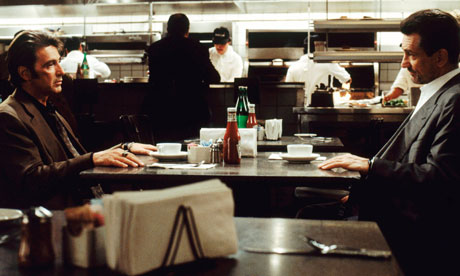Synopsis:
After the tragic death of their infant son, John (Sam Neill) and Rae (Nicole Kidman) decide to embark on a sea vacation to help them cope with their loss. However, after three weeks into their journey, they come across a seemingly deserted sail boat. As they study it from afar, they suddenly notice a man aggressively rowing towards them in a dinghy. Hughie (Billy Zane) comes aboard in a panic and declares that everyone on board that ship has died from food poisoning, and that he is the only survivor. John, in disbelief, decides to search the boat himself, and in an instant, their journey becomes a nightmare in more ways then one.
Analysis:
SPOILERS are included in this piece.
‘Dead Calm’ is a simple film. Its story structure largely focuses on the exploits of three people set adrift-both physically and emotionally-in the Great Barrier Reef (off the coast of Australia). The setting is defined by an extremely vast and spacious landscape, but yet the thematic elements prevalent in the film are of claustrophobia and loneliness. Director Phillip Noyce is able to create a foreboding sense of dread throughout most of the film by incorporating many tight framing shots (especially when he frames Rae’s face) and by staging many scenes in small enclosed areas.
As previously mentioned, ‘Dead Calm’ is a very lonely film. Other than the three characters, this film is devoid of any other human element. And even then, there are very few scenes in which the audience witnesses the three characters interacting with one another on screen. Of course, there are scenes between Rae and Hughie, but for the most part, their isolation from one another highlights how truly cut off these characters are from society and themselves.
Adding to these feelings of isolation and loneliness is, perhaps, the most hauntingly written score ever penned for a feature film. The music is eerily chilling, and creates such a sense of trepidation within the audience that at times the film is overly uncomfortable to watch. Graeme Revell, in charge of the original music for the film, establishes such a sense of unease that it provides the film with an added element of depth. As a result, the overall emotional and psychological impact of the film is heightened.
Australian action cinema* has always concerned itself with depictions of the masculine male. Masculinity is crucial to these particular types of films, and the representation of it is largely enhanced by the male’s assimilation into the wilderness of the Australian backlands. In most Australian action films, there is usually an ongoing tension separating the elements of wilderness and civilization. Men are typically associated with the wilderness while women are usually affiliated with civilization.
In ‘Dead Calm’, the wilderness of the outback is substituted with the limitless boundaries of the sea. In regards to civilization, it remains a foreign, unwelcomed entity as a result of the lawlessness typically associated with the unpredictable nature of water. For the first forty five minutes of the film, typical gender roles are reinforced. John, who is skeptical of Hughie’s story, decides to take on the role of active, participating male and search the other boat himself (leaving Rae alone). While on the other hand, Rae is defined as an inactive contributor. She is still greatly traumatized by her child’s death, and thus acts as caregiver who provides Hughie with drinking water when he arrives on board. When John visits the ship, he understands that the people on Hughie’s boat have not died as a result of food poisoning but rather have been murdered. In a desperate attempt to save Rae, John attempts to return to her on the boat. However, it is too late. Hughie realizes that John knows the truth and attempts to take control of the ship. Rae tries to fight Hughie off but he is too strong for her, and she is knocked unconscious. Hughie turns the boat around and leaves John behind.
It is at this time that the typical gender roles are forced to reverse. Rae must now learn to become an active participant if she is to have any chance of saving her husband. John, on the other hand, has now become an inactive member in the progression of the main storyline because of his isolation from the action. So, as a result of this key plot point, Rae’s character begins to change. She begins to grow stronger and more confident in her abilities. She learns how to load the gun, take control of the boat and defeat Hughie. In the beginning of the film, she was defined as a frail, weakened woman (unable to cope with the loss of her son), but now she has assimilated herself into the role of courageous leader (she is propelling the narrative forward). Rae has absconded with the character typically associated with the male protagonist (her name in itself is highly representative of the masculine traits associated with this individual). Her transition as a character is clearly indicated through Nicole Kidman’s excellent, strong-willed performance.
In perhaps the most telling scene, Rae is able to find and save John from imminent death. In fact, when she does discover and rescue John, she utters the words, “I found you”. Yes, it was her who found him. This woman has conquered the harsh landscape and saved the day. She has successfully subverted all of the masculine ideals Australian action cinema has typically been associated with**.
However, during the making of this film, many studio executives felt that audience members may be confused as to the ambiguous ending of Hughie***. Did he die? Where was he if he did not perish? The studio did not want these questions to linger as debate, so they forced a Hollywood-style ending on the film. Thus, Hughie is not killed by Rae. He returns and proceeds to attack her. She is defenseless and it now becomes John’s job to save her. In one telling instant, everything this film has worked for (the subversion of masculinity) is discarded and the normal gender roles (typical of film) are reinforced. It once again becomes a male versus male battle with the female incapable of action.
In the end, however, this film still remains a wonderful thriller. It is beautifully shot and the acting embraces an unforced naturalness to it. In basic terms, the film is a true classic that leaves one with an undeniable mark afterwards. ‘Dead Calm’ stays with you.
^^Of note, there are many instances where Hughie is associated with the colors of the red, white and blue. To say this Australian film is connoting many negative accusations about America is a monumental understatement.
^^In Tom O’Regan’s book, Australian National Cinema, he provides an idea as to why America is regularly identified as the personification of evil in many foreign film nations (and, on occasions, in American films, as well): “Part of Hollywood’s very popularity turns on its capacity to show American evil through hyperbolic representations of its own social, cultural and political dysfunctionality. And this is a temptation to any national cinema to itself produce American villains as Phil Noyce did in ‘Dead Calm’” (P.283). I’m not sure if this necessarily explains it, but at least it makes a valiant effort at attempting to justify it.
*Action Cinema in general.
** This is a very different type of Australian film. It dares to undermine conventional thematic elements typically associated with Australian national cinema, and save for the ending, is proud of its subversive ways.
***There is great uncertainty in whether or not Hughie is actually dead



